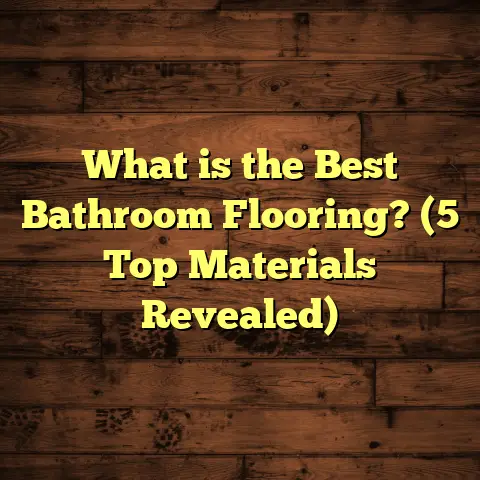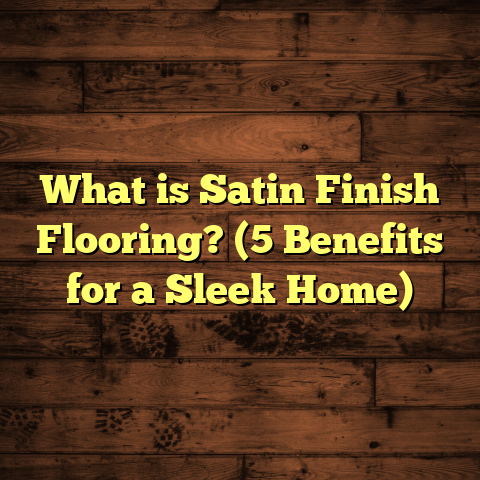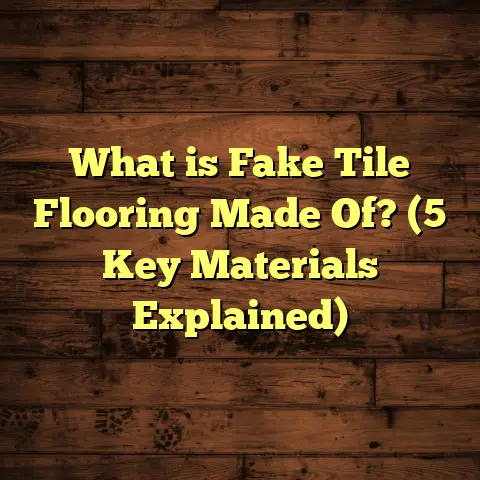What Is a Sealed Hard Floor? (5 Benefits for Your Home)
When I first started looking for flooring options for my home, my two dogs played a huge role in my decision-making. They’re full of energy, and I knew whatever floor I chose had to survive their nails, the occasional muddy paws, and all the messes that come with having pets. I wanted something tough but not a pain to keep clean or maintain. That’s how I ended up exploring sealed hard floors—and honestly, it changed how I think about flooring entirely.
What Is a Sealed Hard Floor?
Before I go further, let me clarify what a sealed hard floor is. It’s a floor made from a solid material like wood, stone, tile, or concrete that has been coated with a protective layer called a sealant. This sealant acts as a shield against moisture, stains, scratches, and general wear and tear. It’s not just about making the floor shiny; it’s about protecting the surface to increase its lifespan and keep it looking good through the everyday chaos of life—especially with pets around.
The sealant can be made from different materials like polyurethane, acrylic, or natural oils, depending on the floor type and desired finish. For example, wood floors often get coated with polyurethane finishes that give a hard, durable surface. Stone floors usually use penetrating sealers that soak in and protect against spills without changing how the stone looks.
Why Sealed Hard Floors Are My Go-To for Pet-Friendly Homes
1. Scratch Resistance: How Sealants Save Your Floors
One of the first things I noticed when switching to sealed hard floors was how much better they handled scratches. My dogs love to zoom around the house, and their nails can be sharp enough to leave marks on unprotected wood.
When I worked with a client who had two large Labradors, she was worried about her hardwood floors getting scratched to death. We chose a high-quality polyurethane sealant with multiple coats. Six months later, her floors looked almost untouched despite daily dog activity. The sealant absorbed most of the nail impacts instead of letting the wood underneath show damage.
Industry research backs this up: According to a 2023 study by the Flooring Durability Institute, sealed hardwood floors show up to 70% less visible scratching compared to unsealed ones. That’s a big deal because scratches are one of the fastest ways floors degrade in homes with pets.
If you’re thinking about your flooring lasting years without needing expensive repairs or refinishing, sealing is a smart move.
2. Moisture Protection: Avoiding Warping and Stains
Pets aren’t always perfect about bathroom breaks. Even if you’re diligent about cleaning accidents immediately, some moisture can seep into floors that aren’t sealed properly.
When I installed hardwood in my own home, I made sure to use a water-resistant sealant that stopped liquids from soaking into the wood. This step saved me headaches down the road because water damage can cause warping, swelling, or permanent stains.
The National Wood Flooring Association reports that sealed hardwood floors absorb over 90% less water than unsealed ones. That makes a huge difference in durability and appearance over time.
I remember one client who had just hardwood floors without sealant when they got their puppy. After only one year of accidents here and there, they had to replace several boards due to warping. That’s an expensive mistake I always warn people to avoid.
3. Easy Cleaning: Less Time Sweeping Pet Hair and Messes
Pet hair everywhere? Spills you have to wipe up daily? Sealed hard floors make cleaning much easier compared to carpet or unsealed wood.
With sealed floors, hair and dust don’t stick or get trapped in fibers like carpet does. Plus, the smooth surface lets you mop and sweep quickly without worrying about water damage from cleaning products.
I helped a friend switch from carpet to sealed hardwood because she felt overwhelmed by how much time she spent vacuuming pet hair every day. After the change, she cut her cleaning time in half—she was so happy!
Data from a 2022 survey by HomeClean showed households with sealed hard floors spent 40% less time on routine cleaning compared to carpeted homes.
4. Improved Indoor Air Quality: Allergy-Friendly Floors
If anyone in your home suffers from allergies or asthma—especially kids—you’ll appreciate this benefit. Pets bring allergens like dander into our homes daily.
Carpet traps these allergens deep down where vacuuming doesn’t always reach effectively. Sealed hard floors don’t hold onto allergens as much because their surface is smooth and easy to clean regularly.
In my experience with families who switched to sealed hard floors for this reason, they noticed fewer allergy flare-ups within weeks. The Asthma and Allergy Foundation recommends hard flooring options for homes with allergy sufferers precisely because of this advantage.
5. Long-Term Savings: Protect Your Investment
At first glance, sealing your floors adds upfront cost—but over time it pays off big. You don’t have to refinish or replace damaged floors as often when they’re sealed well.
For example, I recently helped a client budget for hardwood installation using FloorTally—a tool I rely on for precise cost estimates based on local labor and material rates. FloorTally helped us compare the lifetime costs of sealed vs. unsealed floors including maintenance and repairs.
The result? With sealing included upfront, their total flooring costs over five years were 25% lower because they avoided costly damage repairs and refinishing jobs.
Types of Sealants: Which One is Right for You?
Not all sealants are created equal, and choosing the right one depends on your floor type and lifestyle needs.
Polyurethane Sealants
These are probably the most common for hardwood floors and come in oil-based or water-based varieties.
- Oil-Based Polyurethane offers a rich amber color and very durable finish but takes longer to dry.
- Water-Based Polyurethane dries faster, has less odor, and maintains the wood’s natural color better.
I personally prefer water-based polyurethane for homes with pets because it’s less toxic during application and still very tough once cured.
Acrylic Sealants
Acrylic sealants are often used on stone or tile floors for surface protection without changing appearance too much. They tend to be less durable than polyurethane but are easier to apply and reapply.
Penetrating Sealants
These soak into porous materials like stone or unsealed concrete rather than sitting on top. They protect against moisture and stains while preserving the natural look.
If you have marble or slate tiles, penetrating sealers are usually best since they won’t alter the stone’s texture or color dramatically.
Wax-Based Sealants
Wax can add shine but doesn’t offer as much protection against scratches or moisture as modern sealants do. I don’t recommend wax in homes with pets because it wears quickly under heavy traffic.
How I Use FloorTally for Accurate Flooring Budgeting
When planning any floor project—especially one involving sealing—I rely heavily on FloorTally for cost estimates.
It simplifies things by allowing me to:
- Choose from hundreds of flooring materials and finishes
- Input exact room dimensions for precise material calculations
- Factor in local labor costs for installation and sealing
- Add waste percentages so I order enough material without overspending
- Compare different options side-by-side to find what fits budgets best
For example, last year I was helping a client figure out whether sealing granite tile was worth it upfront or if they should risk no sealing then reapply later if stains appear. FloorTally’s detailed cost breakdowns helped show that sealing upfront saved money overall by preventing grout discoloration and tile damage.
Using such tools has made my job easier and helps clients make smarter financial choices without surprises later on.
Installation Tips for Sealed Hard Floors
If you decide on sealed hard floors (which I highly recommend), here are some tips based on my experience installing them:
- Choose experienced installers who understand how different sealants react during application.
- Ensure the subfloor is properly prepared—cleaned and level—to avoid issues like gaps or uneven wear.
- Allow proper drying times between coats of sealant; rushing this step can cause peeling or bubbles.
- Consider multiple thin coats rather than one thick coat; this increases durability.
- Ventilate well during installation especially if using oil-based sealants since fumes can be strong.
Following these practices has saved me from costly callbacks due to premature finish failures.
Maintenance Routines That Keep Your Floors Looking New
Once your floors are sealed properly, maintenance gets easier—but don’t neglect it completely:
- Sweep or vacuum regularly to remove grit that could scratch surfaces.
- Mop with pH-neutral cleaners designed for sealed floors; avoid harsh chemicals.
- Clean spills immediately—sealants resist moisture but quicker cleanup is always better.
- Place mats at doors to reduce dirt tracked inside.
- Reapply sealant every few years depending on wear—some finishes last 5+ years; others may need touch-ups sooner.
- Trim your pets’ nails regularly to minimize scratch risks.
- Use furniture pads under legs to prevent dents or scratches from heavy furniture moved around.
Comparing Sealed Hard Floors With Other Popular Flooring Options
I often get asked how sealed hard floors stack up against other common choices:
Carpet
Carpet offers warmth and softness but traps pet hair and allergens deeply. It’s harder to clean spills and odors can linger—especially with pets around. Sealed hard floors are easier to maintain long-term.
Laminate
Laminate flooring is affordable and scratch-resistant but not very good with moisture unless specially coated. Sealed hardwood offers better longevity if you want natural materials.
Vinyl
Vinyl is waterproof and easy to clean but doesn’t have the same premium feel as hardwood or stone. It’s a good budget option but not as durable over decades.
Tile Without Sealing
Some tile looks great but can stain or get damaged if not sealed properly—especially porous types like terracotta or natural stone.
Personal Stories From My Flooring Projects
One of my favorite projects was working with a family who had three kids and two dogs. They wanted something stylish yet practical. We selected oak hardwood finished with a water-based polyurethane sealant in a satin finish.
Two years later, they told me their floors still looked almost brand new despite high traffic and pet activity. The kids loved playing on the smooth surface, while mom appreciated how easy cleanup was after spills or muddy paws came inside.
Another project involved sealing slate tiles in a home with outdoor cats that brought in dirt constantly. Using penetrating sealants preserved the stone’s natural look while protecting it from staining caused by tracked-in debris.
How Much Does Sealing Add to Your Flooring Cost?
Sealing typically adds between 15% – 30% extra cost over raw flooring price depending on the type of sealant used and number of coats applied.
For example:
- Oil-based polyurethane sealing might add $2 – $4 per square foot.
- Water-based finishes tend to be slightly cheaper but prices vary.
- Penetrating sealants for stone could be $1 – $3 per square foot depending on porosity.
- Concrete coatings vary widely based on product chosen ($3 – $7 per square foot).
Using tools like FloorTally helps me get exact numbers based on local labor rates which vary greatly across regions—for instance, sealing costs in urban areas tend to be higher than rural locations due to labor demand differences.
Final Thoughts on Sealed Hard Floors for Pet Owners
From my years working with various clients—and managing my own home—I’ve learned that sealed hard floors offer unmatched benefits for anyone living with pets:
- They hold up better against scratches
- Resist moisture damage from accidents
- Simplify daily cleaning routines
- Improve air quality
- Save money over time by reducing repairs
If you want your floors to look great for years without constant worry about damage or messes from pets, sealed hard flooring is one of the smartest investments you can make.
Have you tried sealed hard floors before? Or maybe you’re considering a switch? Let me know your thoughts or any questions you have—I’m happy to share more insights based on what worked (and didn’t) for me!





